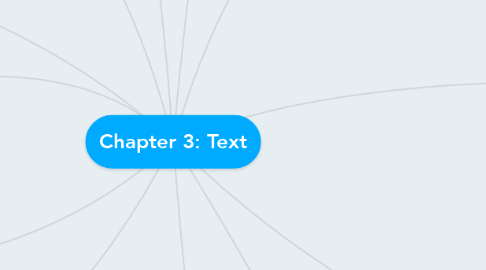
1. Serif VS Sans Serif
1.1. Serif
1.1.1. A serif is the little decoration at the end of a letter stroke.
1.1.2. Serif fonts are used for printed media or documents that have large quantities of text.
1.2. Sans Serif
1.2.1. Sans serif fonts do not have decoration at the end of a letter stroke.
1.2.2. Sans serif fonts are used for headlines and bold statements. It is considered better for computer displays.
2. Cases
2.1. A capitalized letter is referred to as uppercase, while a small letter is referred to as lowercase
3. Text Elements
3.1. Menus for navigation
3.2. Interactive buttons
3.3. Fields for reading
3.4. HTML documents
3.5. Symbols and icons
4. Rasterization
4.1. Font rasterization is the process of converting text from a vector description to a raster or bitmap description
5. Font Mapping
5.1. Specifying which font to be substitution
6. Fontographer
6.1. Fontographer is a specialized graphics editor.
6.2. It can also modify existing typefaces and incorporate PostScript artwork.
7. Hypertext VS Hypermedia
7.1. Hypertext
7.1.1. Hypertext is a text which contains links to other texts.
7.1.2. Hypertext is the subset of hypermedia.
7.2. Hypermedia
7.2.1. Hypermedia is not constrained to be text-based.
7.3. A hypertext or hypermedia system enables the user to navigate through text in a nonlinear way.
8. Importance of Text
8.1. Text is obviously the simplest of data types and requires the least amount of storage.
8.2. Text in the form of symbols, words, sentences, and paragraphs.
8.3. Text is a vital element of multimedia menus, navigation systems, and content.
9. Typeface
9.1. Family of graphic characters, often with many type sizes and styles.
9.1.1. Example : Bookman Old Style
10. Font
10.1. Collection of characters of a single size and style belonging to a particular typeface family.
10.1.1. Example : Arial 18 point Bold
10.2. Font Terminology:
10.2.1. Baseline – the line on which the bases of characters are arranged.
10.2.2. Cap height - cap height refers to the height of a capital letter.
10.2.3. x-height – the distance between the baseline and the top of a lower-case letter x.
10.2.4. Ascenders/descenders – strokes that rise above the x-height/drop below the baseline .
10.2.5. Kerning – adjustment of space between certain pairs of letters (e.g. AV) to make them look more uniform.
10.2.6. Tracking - adjustment of space for groups of letters.
11. Computers and Text
11.1. BITMAP VS VECTOR
11.1.1. Bitmap
11.1.1.1. Bitmaps font consist of a matrix of dots or pixels representing the image.
11.1.2. Vector
11.1.2.1. Vector fonts drawing use instructions and mathematical formulae to describe each glyph.
11.2. Character Sets
11.2.1. Computers can only understand numbers, so an ASCII (American Standard Code for Information Interchange) code is the numerical representation of a character.
11.2.2. Each character is represented by a unique 7-bit binary code word, meaning that there are 128 (27) alternative characters.
11.3. Extended Character
11.3.1. Extra 1 bit in ASCII –up to 256 characters.
11.3.2. is used while programming the text of HTML pages.
11.4. Unicode
11.4.1. Unicode is a 16-bit architecture for multilingual text and character encoding.
11.4.2. Unicode can support a wide variety of non-Roman alphabets including Han Chinese, Japanese, Arabic, Korean, Bengali, and so on.
12. Hypermedia Structure: The simplest way to navigate hypermedia structures is via buttons.
12.1. Links
12.1.1. Links are connections between conceptual elements.
12.2. Nodes
12.2.1. Nodes are accessible topics, documents, messages, and content elements.
12.3. Anchors
12.3.1. An anchor is defined as the reference from one document to another document, image, sound, or file on the Web.

